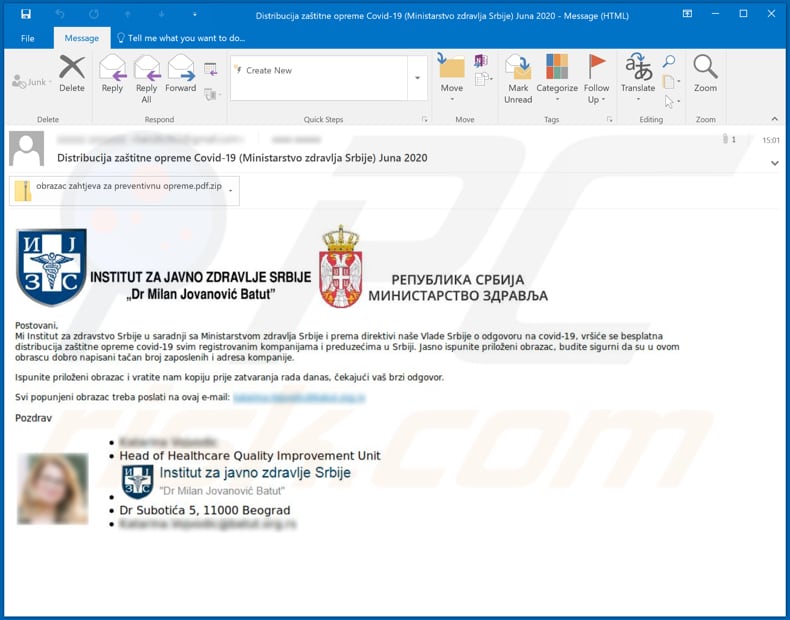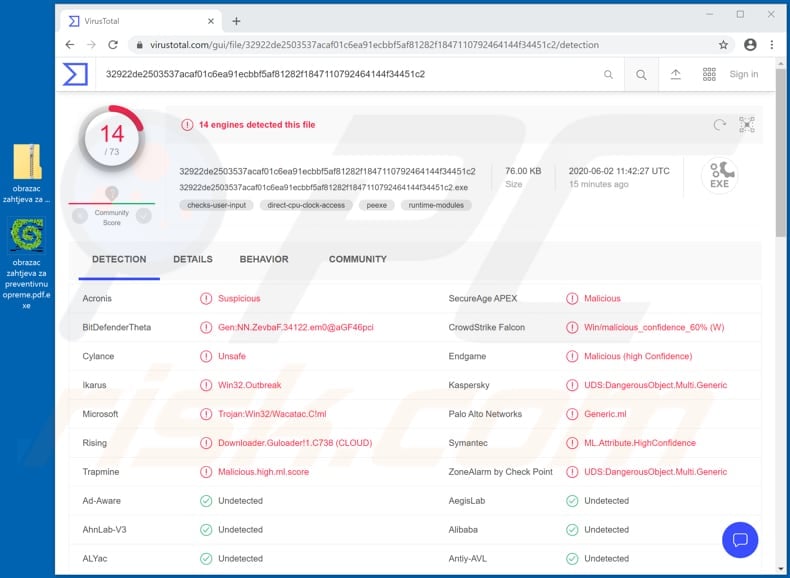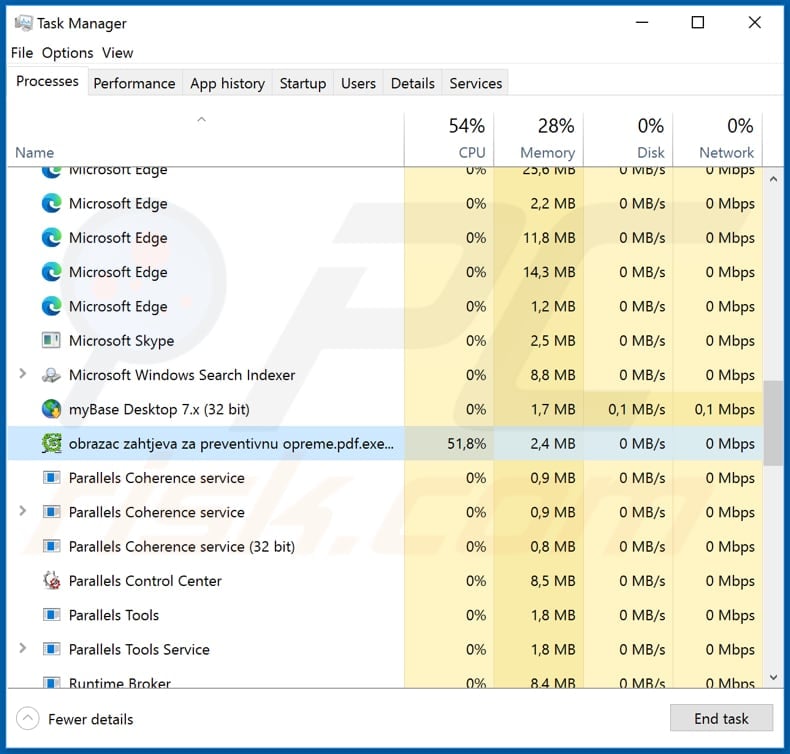Avoid installation of malware via the Institut za zdravstvo Srbije email
Phishing/ScamAlso Known As: Institut Za Zdravstvo Srbije spam
Get free scan and check if your device is infected.
Remove it nowTo use full-featured product, you have to purchase a license for Combo Cleaner. Seven days free trial available. Combo Cleaner is owned and operated by RCS LT, the parent company of PCRisk.com.
What is "Institut za zdravstvo Srbije"?
Cyber criminals increasingly attempt to exploit the coronavirus crisis in various ways. This malspam campaign is disguised as a COVID-19-themed message from Institute of Health of Serbia regarding distribution of protective equipment.
Cyber criminals responsible attempt to trick recipients into infecting their computers with GuLoader through the malicious executable in the attached archive file. Therefore, do not trust this email and leave its attachment unopened.

The email states that companies registered in Serbia can receive free protective equipment, which will supposedly help with COVID-19 infection prevention. This can be done by completing the form and sending it to the email address provided. Recipients will supposedly find the form in the attached archive file ("obrazac zahtjeva za preventivnu opreme.pdf.zip").
In fact, this file contains a malicious executable ("obrazac zahtjeva za preventivnu opreme.pdf.exe"), which, if executed, installs GuLoader, a malicious program used by cyber criminals to distribute other malware.
In summary, if a computer is infected with GuLoader, it is very likely that it will also be infected with a Remote Access Trojan (RAT), ransomware, cryptocurrency miner, or other high-risk malware. Having a computer infected with this malware be the reason behind problems such as identity theft, monetary, data loss, issues relating to online privacy, browsing safety, etc.
Therefore, ignore these emails and do not open files or website links included in them.
| Name | Institut Za Zdravstvo Srbije spam |
| Threat Type | Trojan, password-stealing virus, banking malware, spyware. |
| Hoax | Recipients are offered to apply for a free protection equipment |
| Attachment(s) | obrazac zahtjeva za preventivnu opreme.pdf.zip (its name might vary). |
| Detection Names | Avast (FileRepMalware), BitDefender (Gen:Variant.Razy.677016), ESET-NOD32 (Win32/TrojanDownloader.Agent.FCI), Kaspersky (UDS:DangerousObject.Multi.Generic), Full List Of Detections (VirusTotal). |
| Rogue Process Name | obrazac zahtjeva za preventivnu opreme.pdf.exe (its name might vary). |
| Symptoms | Trojans are designed to stealthily infiltrate the victim's computer and remain silent, and thus no particular symptoms are clearly visible on an infected machine. |
| Payload | GuLoader |
| Distribution methods | Infected email attachments, malicious online advertisements, social engineering, software 'cracks'. |
| Damage | Stolen passwords and banking information, identity theft, the victim's computer added to a botnet. |
| Malware Removal (Windows) |
To eliminate possible malware infections, scan your computer with legitimate antivirus software. Our security researchers recommend using Combo Cleaner. Download Combo CleanerTo use full-featured product, you have to purchase a license for Combo Cleaner. 7 days free trial available. Combo Cleaner is owned and operated by RCS LT, the parent company of PCRisk.com. |
Some more examples of malspam are "Spring Company Invoice Email Virus", "Supreme Court Email Virus", and "Office Depot Email Virus". Typically, these emails are disguised as important, official and sent to deceive users into opening a malicious attachment or file downloaded through an included website - the file infects computers with malware.
In this particular case, by executing the malicious file within the attached ZIP file, recipients install GuLoader. Some examples of malicious programs that are installed through GuLoader are Agent Tesla, FormBook, LokiBot, NetWire, Remcos and Vidar.
How did "Institut za zdravstvo Srbije" infect my computer?
Operating systems are infected through this email only if users extract the attached "obrazac zahtjeva za preventivnu opreme.pdf.zip" file and execute the "obrazac zahtjeva za preventivnu opreme.pdf.exe" file (their names may vary). The installed GuLoader can then be used to infect the system with even more malware.
Other examples of files that cyber criminals attach to their emails are PDF, Microsoft Office documents, other archive files (RAR), executable files (.exe), and JavaScript files.
Note that malicious documents that are opened with Microsoft Office 2010 or newer version infect computers only when users allow the documents to enable macros commands (editing/content). When the documents are opened with older versions, they install malware automatically (since those versions do not include "Protected View" mode).
How to avoid installation of malware
Attachments and website links in irrelevant emails that are received from unknown, suspicious addresses should not be opened. Files and programs should be downloaded via direct links and trustworthy, official websites. Other download channels tools should not be trusted.
Some examples of dubious download/installation channels are third party downloaders, installers, Peer-to-Peer networks (e.g., eMule, torrent clients), and free file hosting pages. Installed software and operating systems must be updated and activated with tools/implemented functions provided by official software developers.
Various 'cracking' (unofficial activation) and third party updaters should not be used. Furthermore, it is illegal to activate software with third party, unofficial tools. Operating systems should be regularly scanned for threats with a reputable antivirus or anti-spyware suite.
Keep this software up to date. If you have already opened "Institut za zdravstvo Srbije" attachment, we recommend running a scan with Combo Cleaner Antivirus for Windows to automatically eliminate infiltrated malware.
Text presented in the "Institut za zdravstvo Srbije" email message:
Subject: Distribucija zaštitne opreme Covid-19 (Ministarstvo zdravlja Srbije) Juna 2020
Postvani,
Mi Institut za zdravstvo Srbije u saradnji sa Ministarstvom zdravlja Srbije i prema direktivi naše Vlade Srbije o odgovoru na covid-19, vršiće se besplatna distribucija zaštitne opreme covid-19 svim registrovanim kompanijama i preduzećima u Srbiji. Jasno ispunite prižoleni obrazac, budite sigurni da su u ovom obrascu dobro napisani tačan broj zaposlenih i adresa kompanije.
Ispunite prižoleni obrazac i vratite nam kopiju prije zatvaranja rada danas, čekajući vaš brzi odgovor.
Svi popunjeni obrazac treba poslati na ovaj e-mail: -
Pozdrav
-
Head of Healthcare Quality Improvement Unit
Institut za javno zdravlje Srbije
"Dr Milan Jovanović Batut"
Dr Subotića 5, 11000 Beograd
-
Malicious executable detected as a threat by multiple detection engines in VirusTotal

Malicious exexutable running in Task Manager as "obrazac zahtjeva za preventivnu opreme.pdf.exe":

Instant automatic malware removal:
Manual threat removal might be a lengthy and complicated process that requires advanced IT skills. Combo Cleaner is a professional automatic malware removal tool that is recommended to get rid of malware. Download it by clicking the button below:
DOWNLOAD Combo CleanerBy downloading any software listed on this website you agree to our Privacy Policy and Terms of Use. To use full-featured product, you have to purchase a license for Combo Cleaner. 7 days free trial available. Combo Cleaner is owned and operated by RCS LT, the parent company of PCRisk.com.
Quick menu:
- What is Institut Za Zdravstvo Srbije spam?
- Types of malicious emails.
- How to spot a malicious email?
- What to do if you fell for an email scam?
Types of malicious emails:
![]() Phishing Emails
Phishing Emails
Most commonly, cybercriminals use deceptive emails to trick Internet users into giving away their sensitive private information, for example, login information for various online services, email accounts, or online banking information.
Such attacks are called phishing. In a phishing attack, cybercriminals usually send an email message with some popular service logo (for example, Microsoft, DHL, Amazon, Netflix), create urgency (wrong shipping address, expired password, etc.), and place a link which they hope their potential victims will click on.
After clicking the link presented in such email message, victims are redirected to a fake website that looks identical or extremely similar to the original one. Victims are then asked to enter their password, credit card details, or some other information that gets stolen by cybercriminals.
![]() Emails with Malicious Attachments
Emails with Malicious Attachments
Another popular attack vector is email spam with malicious attachments that infect users' computers with malware. Malicious attachments usually carry trojans that are capable of stealing passwords, banking information, and other sensitive information.
In such attacks, cybercriminals' main goal is to trick their potential victims into opening an infected email attachment. To achieve this goal, email messages usually talk about recently received invoices, faxes, or voice messages.
If a potential victim falls for the lure and opens the attachment, their computers get infected, and cybercriminals can collect a lot of sensitive information.
While it's a more complicated method to steal personal information (spam filters and antivirus programs usually detect such attempts), if successful, cybercriminals can get a much wider array of data and can collect information for a long period of time.
![]() Sextortion Emails
Sextortion Emails
This is a type of phishing. In this case, users receive an email claiming that a cybercriminal could access the webcam of the potential victim and has a video recording of one's masturbation.
To get rid of the video, victims are asked to pay a ransom (usually using Bitcoin or another cryptocurrency). Nevertheless, all of these claims are false - users who receive such emails should ignore and delete them.
How to spot a malicious email?
While cyber criminals try to make their lure emails look trustworthy, here are some things that you should look for when trying to spot a phishing email:
- Check the sender's ("from") email address: Hover your mouse over the "from" address and check if it's legitimate. For example, if you received an email from Microsoft, be sure to check if the email address is @microsoft.com and not something suspicious like @m1crosoft.com, @microsfot.com, @account-security-noreply.com, etc.
- Check for generic greetings: If the greeting in the email is "Dear user", "Dear @youremail.com", "Dear valued customer", this should raise suspiciousness. Most commonly, companies call you by your name. Lack of this information could signal a phishing attempt.
- Check the links in the email: Hover your mouse over the link presented in the email, if the link that appears seems suspicious, don't click it. For example, if you received an email from Microsoft and the link in the email shows that it will go to firebasestorage.googleapis.com/v0... you shouldn't trust it. It's best not to click any links in the emails but to visit the company website that sent you the email in the first place.
- Don't blindly trust email attachments: Most commonly, legitimate companies will ask you to log in to their website and to view any documents there; if you received an email with an attachment, it's a good idea to scan it with an antivirus application. Infected email attachments are a common attack vector used by cybercriminals.
To minimise the risk of opening phishing and malicious emails we recommend using Combo Cleaner Antivirus for Windows.
Example of a spam email:

What to do if you fell for an email scam?
- If you clicked on a link in a phishing email and entered your password - be sure to change your password as soon as possible. Usually, cybercriminals collect stolen credentials and then sell them to other groups that use them for malicious purposes. If you change your password in a timely manner, there's a chance that criminals won't have enough time to do any damage.
- If you entered your credit card information - contact your bank as soon as possible and explain the situation. There's a good chance that you will need to cancel your compromised credit card and get a new one.
- If you see any signs of identity theft - you should immediately contact the Federal Trade Commission. This institution will collect information about your situation and create a personal recovery plan.
- If you opened a malicious attachment - your computer is probably infected, you should scan it with a reputable antivirus application. For this purpose, we recommend using Combo Cleaner Antivirus for Windows.
- Help other Internet users - report phishing emails to Anti-Phishing Working Group, FBI’s Internet Crime Complaint Center, National Fraud Information Center and U.S. Department of Justice.
Share:

Tomas Meskauskas
Expert security researcher, professional malware analyst
I am passionate about computer security and technology. I have an experience of over 10 years working in various companies related to computer technical issue solving and Internet security. I have been working as an author and editor for pcrisk.com since 2010. Follow me on Twitter and LinkedIn to stay informed about the latest online security threats.
PCrisk security portal is brought by a company RCS LT.
Joined forces of security researchers help educate computer users about the latest online security threats. More information about the company RCS LT.
Our malware removal guides are free. However, if you want to support us you can send us a donation.
DonatePCrisk security portal is brought by a company RCS LT.
Joined forces of security researchers help educate computer users about the latest online security threats. More information about the company RCS LT.
Our malware removal guides are free. However, if you want to support us you can send us a donation.
Donate
▼ Show Discussion